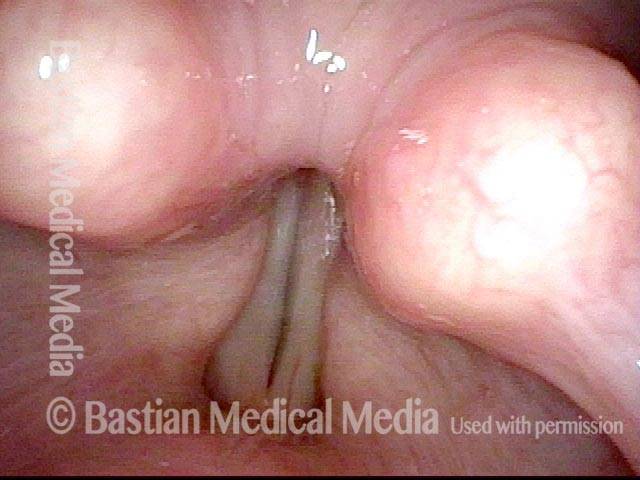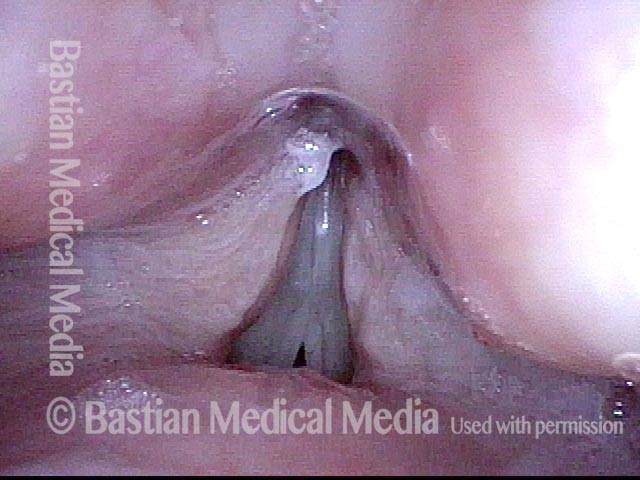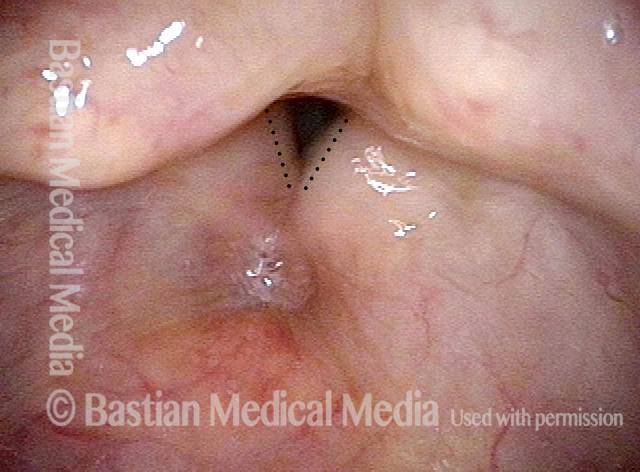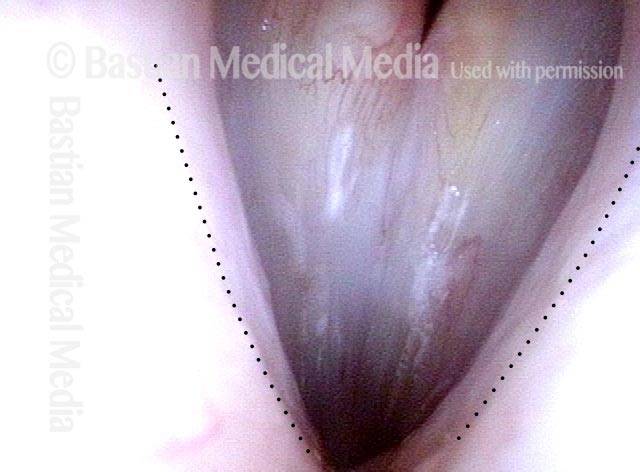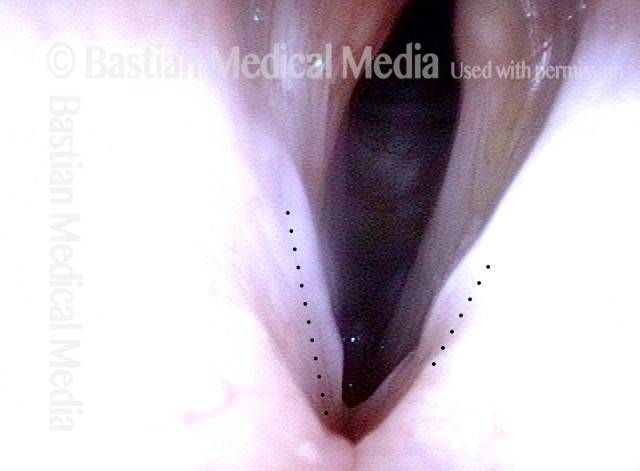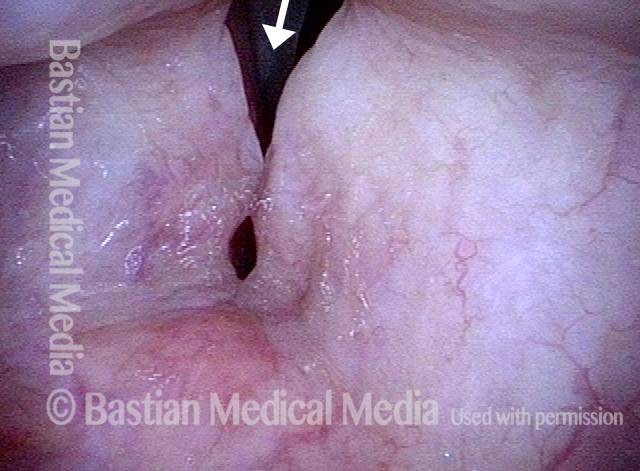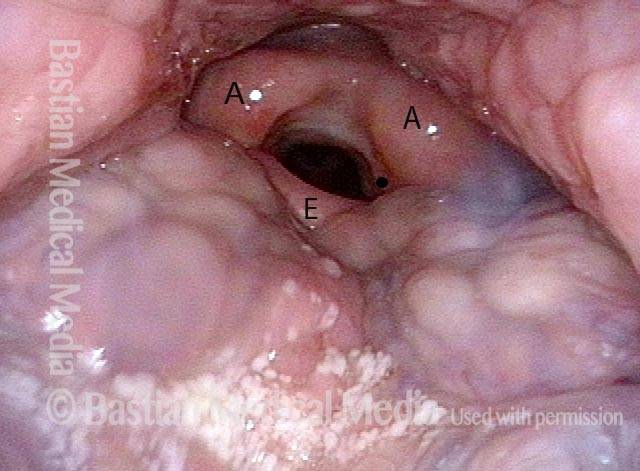False Cord Phonation
False cord phonation is making voice by vibrating the false vocal cords. This kind of phonation is unlike normal phonation or voice-making, which uses the true vocal cords.
This produces a much deeper, rougher voice quality than normal phonation. It is purposefully used in certain kinds of vocal performance, such as Tibetan chant or heavy metal screaming. It can also occasionally serve as an alternate voice for a person whose true cords are unable to vibrate—due, for example, to their surgical removal or to scarring. It can also be produced concurrently with true cord phonation to produce a “Louis Armstrong” effect
False cord phonation due to flaccid true cords (1 of 5): before false cords begin to vibrate
An elderly man, quiet by nature who uses the voice little, complains of weak, gravelly voice quality. This view of phonation, standard light, shows a slightly wider dark line of phonatory blurring. Also, the false vocal cords are overly approximated, but not yet participating in vibration (for that, see images 4 and 5).
False cord phonation due to flaccid true cords (1 of 5): before false cords begin to vibrate
An elderly man, quiet by nature who uses the voice little, complains of weak, gravelly voice quality. This view of phonation, standard light, shows a slightly wider dark line of phonatory blurring. Also, the false vocal cords are overly approximated, but not yet participating in vibration (for that, see images 4 and 5).
False cord phonation due to flaccid true cords (2 of 5): before false cords begin to vibrate
Strobe light reveals an unusually wide amplitude of vibration, denoting flaccidity of the true vocal cords.
False cord phonation due to flaccid true cords (2 of 5): before false cords begin to vibrate
Strobe light reveals an unusually wide amplitude of vibration, denoting flaccidity of the true vocal cords.
False cord phonation due to flaccid true cords (3 of 5): before false cords begin to vibrate
Maximum closed phase shows the telltale residual opening at the anterior commissure (from this perspective, the lowermost end of the true cords), also a potent indicator of flaccidity.
False cord phonation due to flaccid true cords (3 of 5): before false cords begin to vibrate
Maximum closed phase shows the telltale residual opening at the anterior commissure (from this perspective, the lowermost end of the true cords), also a potent indicator of flaccidity.
False cord phonation due to flaccid true cords (4 of 5): after false cords begin to vibrate
When asked to produce louder voice, the false cords begin to participate in vibration, and a rough, gravelly superimposed “ godfather” quality arrives. Notice that the true cords are in at least partial open phase of vibration.
False cord phonation due to flaccid true cords (4 of 5): after false cords begin to vibrate
When asked to produce louder voice, the false cords begin to participate in vibration, and a rough, gravelly superimposed “ godfather” quality arrives. Notice that the true cords are in at least partial open phase of vibration.
False cord phonation due to flaccid true cords (5 of 5): after false cords begin to vibrate
Now the false cords are in open phase of vibration, and the true cords are in maximum closed phase of vibration, with the same residual opening anteriorly seen in photo 3. False cord phonation is not to be seen most accurately as primary here, but as a secondary result of effort necessitated by flaccid true cords.
False cord phonation due to flaccid true cords (5 of 5): after false cords begin to vibrate
Now the false cords are in open phase of vibration, and the true cords are in maximum closed phase of vibration, with the same residual opening anteriorly seen in photo 3. False cord phonation is not to be seen most accurately as primary here, but as a secondary result of effort necessitated by flaccid true cords.
True and False Cord Voice
Thin and weak voice (1 of 4)
This man has a thin and weak voice, often with a superimposed gravelly, rough quality. In this view, false cords, marked with dotted lines, obscure the true cords and their vibration is indicated by blurred margins.
Thin and weak voice (1 of 4)
This man has a thin and weak voice, often with a superimposed gravelly, rough quality. In this view, false cords, marked with dotted lines, obscure the true cords and their vibration is indicated by blurred margins.
True cords during closed phase (2 of 4)
At much closer range under strobe light, the true cords are approximated during the closed phase of vibration. The false cords should remain lateralized throughout voice production (but don’t).
True cords during closed phase (2 of 4)
At much closer range under strobe light, the true cords are approximated during the closed phase of vibration. The false cords should remain lateralized throughout voice production (but don’t).
Flase cords during open phase (3 of 4)
From same viewing position, but during open phase of vibration, showing very “wide” amplitude of vibration caused by flaccidity. The false cords are beginning to come together.
Flase cords during open phase (3 of 4)
From same viewing position, but during open phase of vibration, showing very “wide” amplitude of vibration caused by flaccidity. The false cords are beginning to come together.
False cords during phonation (4 of 4)
Withdrawing the scope slightly, one can now see the false cords have completed their vibratory closure, explaining the superimposed rough quality. The arrow points to where true cords are, hidden in darkness below the false cords.
False cords during phonation (4 of 4)
Withdrawing the scope slightly, one can now see the false cords have completed their vibratory closure, explaining the superimposed rough quality. The arrow points to where true cords are, hidden in darkness below the false cords.
True and False Cord ‘Godfather’ Voice
Bowing (1 of 4)
The true cords are together posteriorly but with major bowing seen at the pre-phonatory instant, to explain the husky, weak quality of voice.
Bowing (1 of 4)
The true cords are together posteriorly but with major bowing seen at the pre-phonatory instant, to explain the husky, weak quality of voice.
Closed phase (2 of 4)
As a result of the need to compress together the weak true cords, false cords also overcompress. This is closed phase of true cords; false cords have not yet reached midline as they are vibrating more slowly than the true cords.
Closed phase (2 of 4)
As a result of the need to compress together the weak true cords, false cords also overcompress. This is closed phase of true cords; false cords have not yet reached midline as they are vibrating more slowly than the true cords.
False cord phonation (3 of 4)
Now the false cords have come into contact but below them the true cords have begun their open phase of vibration. We hear the husky, weak true voice with the superimposed rough, gravelly false cord phonation.
False cord phonation (3 of 4)
Now the false cords have come into contact but below them the true cords have begun their open phase of vibration. We hear the husky, weak true voice with the superimposed rough, gravelly false cord phonation.
True and False cords in open phase (4 of 4)
The true cords are at maximum open phase with enormous lateral excursions typical of flaccid cords. False cords are also at open phase, but as shown in photos 2 and 3, they are vibrating at a lower frequency and out of phase with the true cords.
True and False cords in open phase (4 of 4)
The true cords are at maximum open phase with enormous lateral excursions typical of flaccid cords. False cords are also at open phase, but as shown in photos 2 and 3, they are vibrating at a lower frequency and out of phase with the true cords.
True and False Cords Vibrate Mostly in Tandem (in phase)
True cords vibrate (1 of 4)
At relatively high pitch, only the true cords vibrate. This is closed phase, under strobe light.
True cords vibrate (1 of 4)
At relatively high pitch, only the true cords vibrate. This is closed phase, under strobe light.
Open phase of vibration (2 of 4)
Open phase, same pitch.
Open phase of vibration (2 of 4)
Open phase, same pitch.
True and false cords, closed phase (3 of 4)
At low pitch, where false cord phonation is facilitated. Both true and false cords are in closed phase of vibration (though the true cords are obscured by the false cords).
True and false cords, closed phase (3 of 4)
At low pitch, where false cord phonation is facilitated. Both true and false cords are in closed phase of vibration (though the true cords are obscured by the false cords).
True and false cords, open phase (4 of 4)
Both true and false cords are simultaneously in open phase of vibration.
True and false cords, open phase (4 of 4)
Both true and false cords are simultaneously in open phase of vibration.
Another Voice Without Vocal Cords
Hemilaryngectomy (1 of 4)
After removal of the anterior larynx (hemilaryngectomy) for cancer that recurred after radiation therapy. Though not well seen here, the vocal cords are surgically absent. The black dot seen is for orientation to the next photo. A = arytenoid; E = epiglottis.
Hemilaryngectomy (1 of 4)
After removal of the anterior larynx (hemilaryngectomy) for cancer that recurred after radiation therapy. Though not well seen here, the vocal cords are surgically absent. The black dot seen is for orientation to the next photo. A = arytenoid; E = epiglottis.
Within the larynx (2 of 4)
A view within the larynx. Note again that vocal cords are surgically absent, with only the arytenoid cartilages remaining at the level of the cords. The black dot, on the left arytenoid cartilage, orients to the prior photo. The dot is on the right vocal process.
Within the larynx (2 of 4)
A view within the larynx. Note again that vocal cords are surgically absent, with only the arytenoid cartilages remaining at the level of the cords. The black dot, on the left arytenoid cartilage, orients to the prior photo. The dot is on the right vocal process.
“Wolfman Jack” voice (3 of 4)
The patient is about to produce his rough, “Wolfman Jack” voice but the arytenoid mounds have not yet started to vibrate.
“Wolfman Jack” voice (3 of 4)
The patient is about to produce his rough, “Wolfman Jack” voice but the arytenoid mounds have not yet started to vibrate.
Arytenoid vibration (4 of 4)
Aggressive voice use brings arytenoid mounds into vibration (notice blurring). With time and practice, this kind of supraglottic voice can serve moderately well, but it is always difficult to be heard in competition with background noise.
Arytenoid vibration (4 of 4)
Aggressive voice use brings arytenoid mounds into vibration (notice blurring). With time and practice, this kind of supraglottic voice can serve moderately well, but it is always difficult to be heard in competition with background noise.
Tagged Anatomy & Physiology, Audio, Education, Photos
